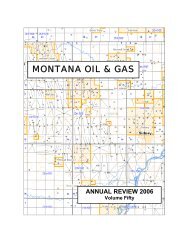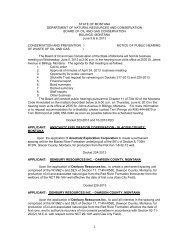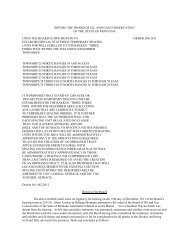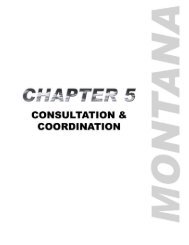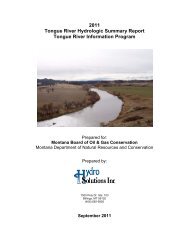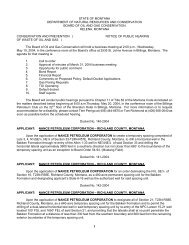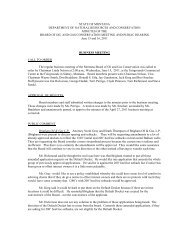Microsoft Office Outlook - Memo Style - Montana Board of Oil and Gas
Microsoft Office Outlook - Memo Style - Montana Board of Oil and Gas
Microsoft Office Outlook - Memo Style - Montana Board of Oil and Gas
You also want an ePaper? Increase the reach of your titles
YUMPU automatically turns print PDFs into web optimized ePapers that Google loves.
New Rule II – Disclosure <strong>of</strong> Well Stimulation Fluids<br />
In sections (1) through (3), the recommended parameters for disclosure are a start.<br />
However, in order for these to be fully effective, we feel no exceptions should be<br />
allowed. In particular, Northern Plains <strong>and</strong> CRC have concerns with section 4 (a). We<br />
believe that it is essential this information is easily accessible on the internet <strong>and</strong> that a<br />
local, third party such as the BOGC should post this information. Therefore, we do not<br />
recommend the use <strong>of</strong> the Interstate <strong>Oil</strong> <strong>and</strong> <strong>Gas</strong> Compact Commission/Groundwater<br />
Protection Council hydraulic fracturing website <strong>and</strong> would urge the BOGC to post this<br />
information instead.<br />
Also, from perusing their website as set up now, it is extremely hard to find out where the<br />
wells are located unless a GPS device is on h<strong>and</strong>. A map that pinpoints where these wells<br />
are located is necessary to make internet disclosure more helpful. After searching for<br />
<strong>Montana</strong> wells on the FracFocus website, only one well is posted currently (see<br />
attachment 2) <strong>and</strong> 6 <strong>of</strong> the chemicals on the list are considered proprietary. This is<br />
inadequate <strong>and</strong> will not help l<strong>and</strong>owners determine required baseline testing parameters.<br />
New Rule III – Proprietary Chemicals <strong>and</strong> Trade Secrets<br />
Section (1) <strong>of</strong> Rule III is not protective <strong>of</strong> public health <strong>and</strong> our l<strong>and</strong> <strong>and</strong> water. What<br />
use is public disclosure if many <strong>of</strong> the components fall under the trade secret heading?<br />
We recommend <strong>Montana</strong> adopt a similar approach to that taken in Wyoming, which<br />
requires operators to actively apply for a trade secret exemption. However, in contrast to<br />
Wyoming we also recommend that any protections for proprietary information must be<br />
carefully defined, with a clear decision making process <strong>and</strong> st<strong>and</strong>ard <strong>of</strong> pro<strong>of</strong>, <strong>and</strong> must<br />
provide for the release <strong>of</strong> the adverse health effects <strong>of</strong> each chemical that is kept secret,<br />
release <strong>of</strong> proprietary information in the event <strong>of</strong> a medical necessity, <strong>and</strong> regular review<br />
<strong>and</strong> appeal <strong>of</strong> proprietary designations.<br />
Section (2) <strong>of</strong> Rule III requires that an operator provide a list <strong>of</strong> chemical constituents<br />
contained in a proprietary chemical upon request only in the event <strong>of</strong> a spill or release <strong>of</strong><br />
that chemical. It is recommended that this chemical information be provided to the<br />
BOGC <strong>and</strong> the local emergency response departments well before any spills occur. This<br />
will hopefully ensure an appropriate <strong>and</strong> timely response for emergency personnel <strong>and</strong><br />
environmental cleanup that is protective <strong>of</strong> human health <strong>and</strong> will minimize impacts to<br />
the environment.<br />
Section (3) is prohibitive to medical personnel. Providing a written statement in the midst<br />
<strong>of</strong> treating a patient is extremely restrictive <strong>of</strong> that medical pr<strong>of</strong>essional’s ability to<br />
administer timely treatment. We recommend removing the written statement section or at<br />
least allowing for it to be implemented after the treatment has occurred in order to<br />
prevent any delay as in Section (4).



